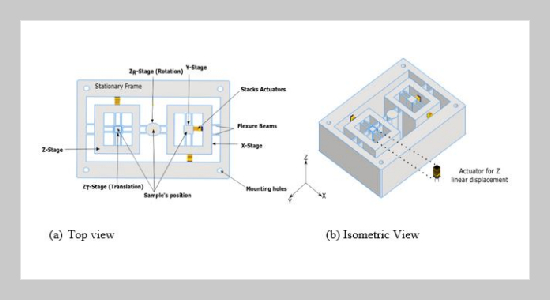REFERENCES
- [1] Nicolae Lobontiu, Matt Cullin, Todd Petersen, Javier A. Alcazar, and Simona Noveanu. Planar compliances of symmetric notch flexure hinges: The right circularly corner-filleted parabolic design. IEEE Transactions on Automation Science and Engineering, 11(1):169–176, 2014.
- [2] Yuki Shimizu, Yuxin Peng, Junji Kaneko, Toyohiro Azuma, So Ito, Wei Gao, and Tien Fu Lu. Design and construction of the motion mechanism of an XY microstage for precision positioning. Sensors and Actuators, A: Physical, 201:395–406, 2013.
- [3] Fujun Wang, Cunman Liang, Yanling Tian, Xingyu Zhao, and Dawei Zhang. A flexure-based kinematically decoupled micropositioning stage with a centimeter range dedicated to micro/nano manufacturing. IEEE/ASME Transactions on Mechatronics, 21(2):1055– 1065, 2016.
- [4] Haiyue Zhu, Chee Khiang Pang, and Tat Joo Teo. A Flexure-Based Parallel Actuation Dual-Stage System for Large-Stroke Nanopositioning. IEEE Transactions on Industrial Electronics, 64(7):5553–5563, 2017.
- [5] Kok Kiong Tan, Wenyu Liang, Sunan Huang, Le Phuong Pham, Silu Chen, Chee Wee Gan, and Hsueh Yee Lim. Precision control of piezoelectric ultrasonic motor for Myringotomy with tube insertion. Journal of Dynamic Systems, Measurement and Control, Transactions of the ASME, 137(6), 2015.
- [6] Wesley Johnson, Changsheng Dai, Jun Liu, Xian Wang, Devin K. Luu, Zhuoran Zhang, Changhai Ru, Chao Zhou, Min Tan, Huayan Pu, Shaorong Xie, Yan Peng, Jun Luo, and Yu Sun. A Flexure-Guided Piezo Drill for Penetrating the Zona Pellucida of Mammalian Oocytes. IEEE Transactions on Biomedical Engineering, 65(3):678– 686, 2018.
- [7] Piyu Wang and Qingsong Xu. Design and Testing of a Flexure-Based Constant-Force Stage for Biological Cell Micromanipulation. IEEE Transactions on Automation Science and Engineering, 15(3):1114–1126, 2018.
- [8] Qingsong Xu and Qingsong Xu. Review of Microinjection Systems. In Micromachines for Biological Micromanipulation, pages 15–47. Springer International Publishing, 2018.
- [9] Shrikantha S. Rao, Mervin A. Herbert, Prakash Vinod, T. Narendra Reddy, and SN Vithun. Development of high speed closed loop operation for single notch flexure-based nanopositioning system. International Journal of Precision Technology, 7(1):1, 2017.
- [10] Bernard Ouma Alunda, Yong Joong Lee, and Soyeun Park. Comparative study of two types of parallel kinematic flexure scanners for atomic force microscopy. Instrumentation Science and Technology, 46(1):58–75, jan 2018.
- [11] Zhen Zhang, Xiaodong Yang, and Peng Yan. Large dynamic range tracking of an XY compliant nanomanipulator with cross-axis coupling reduction. Mechanical Systems and Signal Processing, 117:757–770, 2019.
- [12] Yanding Qin, Bijan Shirinzadeh, Yanling Tian, Dawei Zhang, and Umesh Bhagat. Design and computational optimization of a decoupled 2-DOF monolithic mechanism. IEEE/ASME Transactions on Mechatronics, 19(3):872–881, 2014.
- [13] Qingsong Xu. Design and development of a flexure-based dual-stage nanopositioning system with minimum interference behavior. IEEE Transactions on Automation Science and Engineering, 9(3):554–563, 2012.
- [14] R Bharanidaran and Sai Aswin Srikanth. A new method for designing a compliant mechanism based displacement amplifier. In IOP Conference Series: Materials Science and Engineering, volume 149. Institute of Physics Publishing, oct 2016.
- [15] B.J. Kenton and K.K. Leang. Design and control of a three-axis serial-kinematic high-bandwidth nanopositioner. IEEE/ASME Transactions, 17(2), 2011.
- [16] Y K Yong, S. O.R. Moheimani, B J Kenton, and K K Leang. Invited review article: High-speed flexureguided nanopositioning: Mechanical design and control issues, dec 2012.
- [17] D Croft, G. Shedd, and S Devasia. Creep, hysteresis, and vibration compensation for piezoactuators: Atomic force microscopy application. Proceedings of the American Control Conference, 3:2123–2128, 2000.
- [18] Johannes Maess, Andrew J. Fleming, and Frank Allgöwer. Simulation of dynamics-coupling in piezoelectric tube scanners by reduced order finite element analysis. Review of Scientific Instruments, 79(1), 2008.
- [19] Szuchi Tien, Santosh Devasia, and Qingze Zou. Iterative Control of Dynamics-Coupling-Caused Errors in Piezoscanners During High-Speed AFM Operation. IEEE Transactions on Control Systems Technology, 13(6):921–931, 2005.
- [20] Qingsong Xu. New flexure parallel-kinematic micropositioning system with large workspace. IEEE Transactions on Robotics, 28(2):478–491, 2012.
- [21] Sachin P. Wadikhaye, Yuen Kuan Yong, and S. O. Reza Moheimani. A serial-kinematic nanopositioner for highspeed atomic force microscopy. Review of Scientific Instruments, 85(10), oct 2014.
- [22] Qian Lu, Xifu Chen, and Weiqing Huang. A novel rhombic piezoelectric actuator applied in precision positioning stage. Journal of Applied Science and Engineering, 23(3):405–411, 2020.
- [23] Abdenbi Mohand-Ousaid, Dominique Gendreau, Patrick Rougeat, and Micky Rakotondrabe. Design, static modeling and simulation of a 5-DOF precise piezoelectric positioner. In Sensors for Next-Generation Robotics III, volume 9859, page 98590A, 2016.
- [24] S.C. Obilikpa and K.I. Anazodo. Design and simulation of a smart Decoupled Nanopositioner. 2019.
- [25] Tiberiu Gabriel Zsurzsan, Charles Mangeot, Michael A.E. Andersen, Zhe Zhang, and Nils A. Andersen. Piezoelectric stack actuator parameter extraction with hysteresis compensation. In 2014 16th European Conference on Power Electronics and Applications, EPE-ECCE Europe 2014, 2014.
- [26] S C Obilikpa. Robust H-infinity control of two novel MEMS force sensors. IOP SciNotes, 1(2):024406, 2020.
- [27] Noraxon. Product Catalog. Measurement, pages 1–20, 2008.
- [28] Peng Gao and Shan Min Swei. Six-degree-of-freedom micro-manipulator based on piezoelectric translators. Nanotechnology, 10(4):447–452, dec 1999.
















